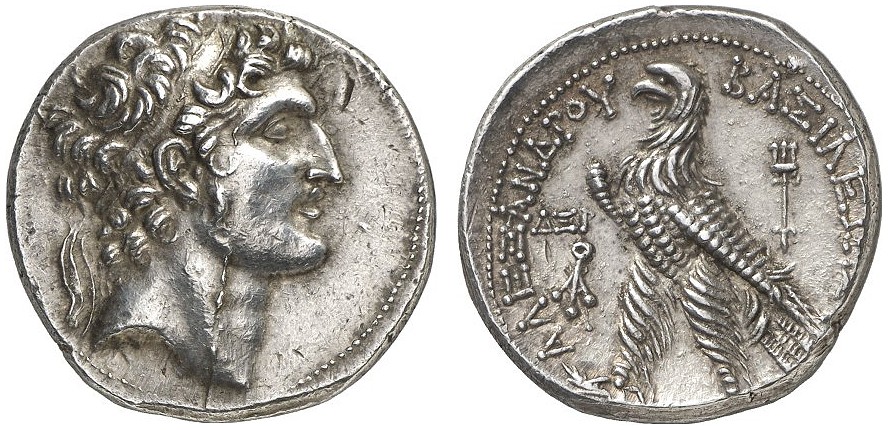Berytus (Alexander Balas), silver, tetradrachms (Alexander/eagle on thunderbolt) (151-150 BCE)
From SILVER
(Redirected from S 110 - Berytus (Alexander Balas), silver, tetradrachms (151-145 BCE))
151 BCE - 150 BCE Silver 6,833 kg
Description
| ObverseInscription or printing placed on the obverse.: | Diademed head of Alexander I right, diadem ends falling straight behind, dotted border |
| ReverseInscription or printing placed on the reverse.: | ΑΛΕΞΑΝΔΡΟΥ-BAΣIΛEΩΣ (Greek).Eagle on a palm to left, closed wings |
Mint and issuing power
| MintIdentifies the place of manufacture or issue of a numismatic object.: | Berytus / Laodicea in Phoenicia | Ancient regionAncient region.: | Phoenicia | Modern countryModern country: Lebanon | AuthorityIdentifies the issuing power. The authority can be "pretended" when the name or the portrait of X is on the coin but he/she was not the issuing power. It can also be "uncertain" when there is no mention of X on the coin but he/she was the issuing power according to the historical sources: | Seleucid Dynasty (312-63 BC), Alexander I Balas (Seleucid king, 152-145 BC) |
Chronology
| FromIdentifies the initial date in a range assigned in a numismatic context. | 151 BCE | toIdentifies the final date in a range assigned in a numismatic context.. | 150 BCE | PeriodTime period of the numismatic object.: Hellenistic 323-30 BC |
Physical description
| MetalThe physical material (usually metal) from which an object is made.: | Silver |
Median weightMedian of the weights of numismatic objects (in grams). in grams | 14.10 | DenominationTerm indicating the value of a numismatic object. Examples: tetradrachm, chalkous, denarius.: | tetradrachm |
StandardStandard.: | Attic |
Image

S 110 - Berytus (Alexander Bala), silver, tetradrachms (151-145 BCE).jpg [1]
References
| Die study referencePublication of the study: | Sawaya 20051Sawaya 2005, p. 109 et passim | ||
| Coin series referenceReference to coin series study: | HGC 92HGC 9, n° 881, SC II3SC II, n° 1824.2 | ||
| Coin series web referenceCoin series web references: | |||
Obverse dies distribution
| FrequencyFrequency of specimen in distribution. ᵖ | Number of obversesNumber of obverse dies. ᵖ (o) | % (o) | Number of coinsNumber of coins. (n) | % (n) | Die nameName(s) of the die(s). |
| 1 | 9 | 50 | 9 | 18.75 | 1, 4, 6, 9, 11, 13, 15, 16, 18 |
| 2 | 3 | 16.67 | 6 | 12.5 | 10, 12, 17 |
| 3 | 1 | 5.56 | 3 | 6.25 | 7 |
| 4 | 2 | 11.11 | 8 | 16.67 | 2, 3 |
| 5 | 1 | 5.56 | 5 | 10.42 | 8 |
| 8 | 1 | 5.56 | 8 | 16.67 | 14 |
| 9 | 1 | 5.56 | 9 | 18.75 | 5 |
| Total | 18 of 18 | 100.02 | 48 of 48 | 100.01 |
Reverse dies distribution
no distribution is available
Quantification
| Number of obversesNumber of obverse dies. ᵖ (o) | 18 | Number of singletons (o1)The number of singleton coins. ᵖ | 9 |
| Number of reverse diesNumber of reverse dies. (r) | 36 | Number of coinsNumber of coins. (n) | 48 |
| Coins per obverse dieNumber of coins per obverse die. (n/o) | 2.67 | Coins per reverse dieNumber of coins per reverse die. (n/r) | 1.33 |
| Reverse per obverse ratioRatio of obverse dies divided by reverse dies. (r/o) | 2 | Percentage of singletons (o1)number of coins (n) divided by the number of singletons (o1) ᵖ | 50 % |
| Original number of dies (O) (Carter 1983 formula)The estimation of the number of coins according to Carter 1983 ᵖ | 24.23 | Coins struck if 20,000 as average productivity per dieCoins made if the average productivity for obverses (according to Carter) is 20,000. ᵖ | 484,600 |
| Original number of dies (O) (Esty 2011 formula)The estimation of the number of coins according to the singleton formula in Esty 2011 ᵖ (O) | 28.8 | Survival rate if 20,000 as average productivity per dieSurvival rate if average productivity is 20,000. ᵖ | 0.00010 |
| Coverage (o = % of O) (Esty 1984 formula)Esty 1984 - coverage (% of O) ᵖ (o = % of O) | 81.25% | Die productivity if survival rate 1/2,000Average productivity if survival rate is 1/2,000. ᵖ | 3,962.03 |
| Weight of silver (in kg) if 20,000 coins per die (O = Carter formula)Carter 1983 * Median weight * 20000 (*10 if gold or electrum) ᵖ | 6,833 kg <br /> 6,833 kg | Die productivity if survival rate 1/5,000Average productivity if survival rate is 1/5,000. ᵖ | 9,905.08 |
Remarks
Most likely one single workstation Likely military
References
- ^ Sawaya, Ziad (2005), "Les tétradrachmes Séleucides à l’Aigle de Bérytos", The Numismatic Chronicle, 165, p. 99-124, pl. 9-14.
- ^ Hoover, Oliver D. (2009), Handbook of ancient Syrian coins : royal and civic issues, fourth to first centuries BC, The Handbook of Greek Coinage 9, Lancaster, lxix, 332 p.
- ^ Houghton, Arthur - Lorber, Catharine C. - Hoover, Oliver D. (2008), Seleucid coins : a comprehensive catalogue. Part 2, Seleucus IV through Antiochus XIII, 2 v., New York - Lancaster - London, (xxx), 120 p. of plates : ill., maps, tables